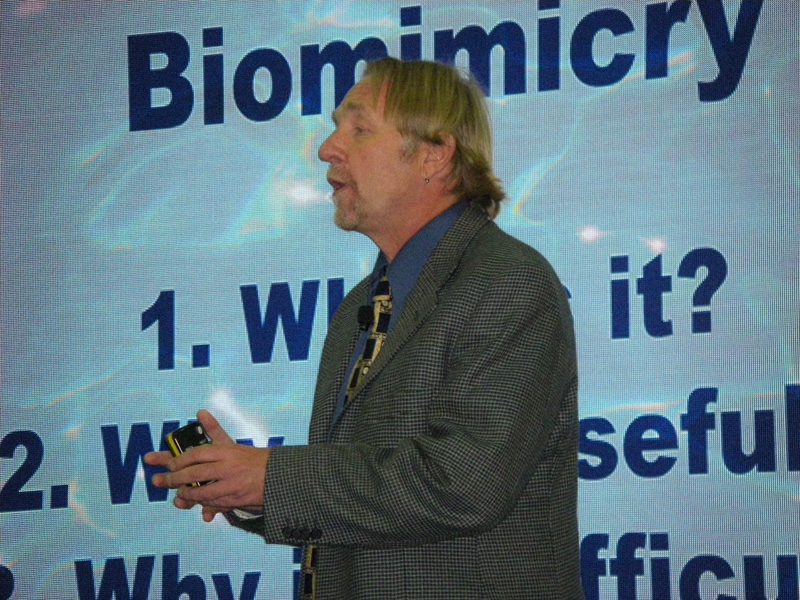 在SAE全球汽车年会的Tech Hub大厅中,多项专利所有者Pete Foley向一名在场观众解释,工程师可以借助仿生学“找到在其他任何地方都闻所未闻的解决方案。”
在SAE全球汽车年会的Tech Hub大厅中,多项专利所有者Pete Foley向一名在场观众解释,工程师可以借助仿生学“找到在其他任何地方都闻所未闻的解决方案。”  日本新干线高铁的设计借鉴了翠鸟的外形,从而实现了更低噪声、更低电耗及更高的行驶速度。
日本新干线高铁的设计借鉴了翠鸟的外形,从而实现了更低噪声、更低电耗及更高的行驶速度。 日本新干线高铁的设计借鉴了翠鸟的外形,从而实现了更低噪声、更低电耗及更高的行驶速度。
日本新干线高铁的设计借鉴了翠鸟的外形,从而实现了更低噪声、更低电耗及更高的行驶速度。
所有动物,无论是鸟类还是哺乳动物,都是天生的发明家,可以启发汽车工程师的创新技术设计,这就叫做仿生学。
“当人们最开始有飞翔的念头时,他们做的第一件事就是观察鸟类。”发明家Pete Foley站在SAE2016全球汽车年会Tech Hub 技术中心的演讲上,满怀信心地告诉参展的观众,“如今我们仍然在向自然学习,大自然中有太多可以借鉴的‘研发项目’,正因为如此,我对仿生学的潜力坚信不移。”
但我们想要真正飞起来,并不能仅仅靠观察鸟类。
他说,“你必须真正深入到每一处细节,了解鸟类在飞翔时的空气动力学状态,它们的结构性材料组成和功率质量比,你还得了解它们的热力学计算数据。”
过去10年来,已经拥有超过100项专利的Foley一直致力于将行为学的概念应用到产品设计之中。
他断言,“如果你遇到一个问题,那我基本可以确定,自然界中一定有什么地方存在现成的解决方案。”
问题是该去哪里寻找这些解决方案。Foley表示,“第二个挑战在于材料与技术之间的匹配。一般来说,自然和人类工程师选择的材料非常不同。”他指出,自然界中的解决方案通常需要经过一定时间的适应与进化,才能真正成型。
如何阐述一个问题,会对最终能否找到解决方案产生极大影响。
Foley表示,“你必须有足够的抽象思维能力,才能在自然界中找到合适的类比。”举例而言,当工程师希望解决一个油泵的问题时,如果他能以正确的方式描述这个问题,那一定可以从与生物学家的交流中受益匪浅。
Foley表示,“如果你能将困难描述成‘我遇到了液体在系统中流动的问题’、‘我遇到了液体在系统中分配的问题’,又或是‘我遇到了在存在流动液体的情况下,需要持续保持压强的问题’,将遇到的困难总结到这种程度,相信你一定可以从生物学家那里收获良多。”
现实中存在大量借鉴自然的技术应用。“仿生学在汽车相关行业中也有应用。”Foley指出,日本新干线(shinkansen)高铁独特的空气动力学前脸设计,就模拟了翠鸟的形状,“翠鸟可以在几乎不受任何干扰的情况下,直插水中。另外,还有部分火车的结构设计,借鉴了雪鸮的翼尖形状。雪鸮是一种大鸟,几乎不会发出任何声音,因此设计师就从雪鸮那里‘偷师’,从而降低了火车的噪声。”
仿生学能否在汽车行业大放异彩,这仍有待确定。
“我认为人们很难将从自然中学到的东西与我们遇到的困难对应起来,”Foley表示,“如果你想通过自然的启发实现创新,那一定要学会耐心,还要做好辛苦研究的准备。”
作者:Kami Buchholz
来源:SAE《汽车工程》杂志
翻译:SAE 上海办公室
2016 SAE Congress: Is biomimicry in your design future?
Animals, birds, and mammals are natural-born innovators that can inspire automotive engineers to create novel technologies. The term for such an influence is biomimicry.
“When people first wanted to fly, they went and looked at birds,” inventor Pete Foley cheerily reminded a 2016 SAE World Congress audience at the popular Tech Hub area in Detroit's Cobo Hall. “We’re still borrowing from nature. The reason I think [biomimicry] has so much potential is because there is so much R&D in nature.”
But just observing birds isn’t the entire answer to flight.
“You really have to get into the details. When it comes to flight and birds, that means you have to understand the aerodynamics of how a bird flies. You have to understand the structural materials of a bird. You have to understand power-to-weight ratios. And you have to understand the [thermal] computations,” he said.
For the past decade Foley, with more than 100 granted or published patents in his portfolio, has applied behavioral science to product design.
“If you’ve got a problem, it’s almost guaranteed that somewhere out in nature it’s been solved,” he asserted.
The first difficulty is knowing where to look. “The second challenge is matching materials and technology. Nature and human engineers tend to work with very different materials,” Foley said. He noted that nature-found solutions typically require a considerable amount of adaptation to elicit a usable application.
How a problem is defined can greatly influence the solution outcome.
“You have to get the right level of abstraction to allow analogies,” said Foley. As an example, if an engineer wanted to solve a fuel pump problem, a conversation with a biologist could be very beneficial—if the fuel pump problem is presented in the right context.
“If you can frame the issue in terms of, ‘I’ve got a problem with moving liquid around the system’, or ‘I’ve got a problem with distributing liquid in a system’, or ‘I’ve got a problem keeping pressure consistent through a system where liquid is moving around.’ If you can describe things at the right level, you can have some very good conversations with biologists,” Foley said.
There are notable examples of nature’s ways being adapted for technology applications. “Biomimicry is being used in related industries,” Foley said, citing Japan's shinkansen high-speed trains whose aerodynamic noses mimic a kingfisher bird’s shape. “A kingfisher can penetrate water with virtually no disturbance whatsoever. And some of the smaller [train] structure is [akin] to the wing tips of a snowy owl. It’s a big bird, and it’s completely silent. They’ve stolen some of the technology from the snowy owl to reduce the noise of those trains.”
The future of biomimicry in the automotive industry is yet to be determined.
“I think that it’s been quite hard for people to make that translation from the technology in nature to the problems we’ve got,” said Foley, “If you want to use nature as inspiration for innovation, you’ve got to be patient. And you’ve got to be willing to roll your sleeves up.”
Author: Kami Buchholz
Source: SAE Automotive Engineering Magazine
等级
打分
- 2分
- 4分
- 6分
- 8分
- 10分
平均分
